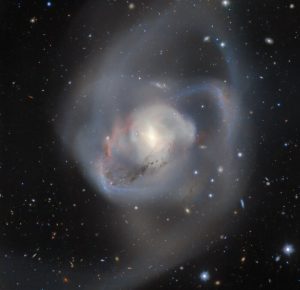
Time is perhaps the most important building block in massive galaxies. In November, NOIRLab released a remarkable image of the galaxy NGC7727 that was taken with the Gemini South Observatory. Seen in colors similar to what our eyes can see, this image reveals how two merging spiral galaxies can create truly beautiful destruction. The arcs and blue highlights in the image, which we have on our website, are pulled out tails of gas and dust that are, in some places, forming stars at incredible rates.
Remarkably, 23 knots of material found in this mess of gas, dust, and stars appear to be newly formed Globular Clusters, adding support to the theory that Globular Clusters form where material is slammed together during mergers.
Deep in the heart of these two systems is a pair of supermassive black holes, one from each of the original galaxies. Throughout the merger, they have been migrating closer and closer, and now they are just 1600 light years apart. It’s hard to know exactly when this merger started, but we do have a sense of when the most exciting part will end. If our models are correct, in about 250 million years, those two supermassive stars will merge in an almighty release of gravitational waves. With a distance of just 90 million years, this system is far enough away to pose no risk while near enough to potentially give whatever life is kicking around in a quarter billion years one heck of a good view.
And before you worry about where we’ll be, I checked and our solar system will have completed one full orbit around the Milky Way, so we should have unobscured seating for the show.
For now, this is just an image release. When science teams have completed their analysis, we’ll bring it to you here.
